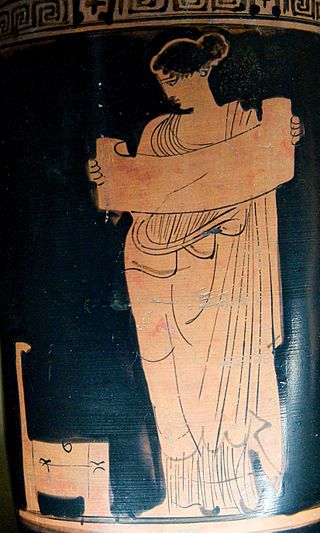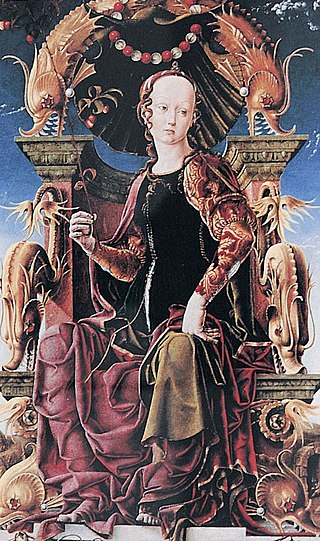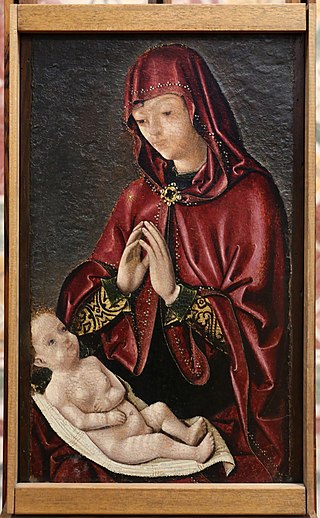
An artist is a person engaged in an activity related to creating art, practicing the arts, or demonstrating an art. The common usage in both everyday speech and academic discourse refers to a practitioner in the visual arts only. However, the term is also often used in the entertainment business, especially in a business context, for musicians and other performers. "Artiste" is a variant used in English in this context, but this use has become rare. The use of the term "artist" to describe writers is valid, but less common, and mostly restricted to contexts such as critics' reviews.

Euterpe was one of the Muses in Greek mythology, presiding over music. In late Classical times, she was named muse of lyric poetry. She has been called "Giver of delight" by ancient poets.

In ancient Greek religion and mythology, the Muses are the inspirational goddesses of literature, science, and the arts. They were considered the source of the knowledge embodied in the poetry, lyric songs, and myths that were related orally for centuries in ancient Greek culture.

In Greek mythology, Erato is one of the Greek Muses, the inspirational goddesses of literature, science, and the arts. The name would mean "desired" or "lovely", if derived from the same root as Eros, as Apollonius of Rhodes playfully suggested in the invocation to Erato that begins Book III of his Argonautica.

In Greek mythology, Melpomene is the Muse of tragedy in Greek mythology. She is described as the daughter of Zeus and Mnemosyne along with the other Muses, and she is often portrayed with a tragic theatrical mask.

Guarino Veronese or Guarino da Verona was an Italian classical scholar, humanist, and translator of ancient Greek texts during the Renaissance. In the republics of Florence and Venice he studied under Manuel Chrysoloras, renowned professor of Greek and ambassador of the Byzantine emperor Manuel II Palaiologos, the first scholar to hold such course in medieval Italy.

Cosmê Tura, also known as Il Cosmè or Cosimo Tura, was an Italian early-Renaissance painter and considered one of the founders of the School of Ferrara.

Palazzo Schifanoia is a Renaissance palace in Ferrara, Emilia-Romagna (Italy) built for the Este family. The name "Schifanoia" is thought to originate from "schifare la noia" meaning literally to "escape from boredom" which describes accurately the original intention of the palazzo and the other villas in close proximity where the Este court relaxed. The highlights of its decorations are the allegorical frescoes with details in tempera by or after Francesco del Cossa and Cosmè Tura, executed ca 1469–70, a unique survival of their time.

Palazzo dei Diamanti is a Renaissance palace located on Corso Ercole I d'Este 21 in Ferrara, region of Emilia Romagna, Italy. The main floor of the Palace houses the Pinacoteca Nazionale di Ferrara.

The Parnassus is a fresco painting by the Italian High Renaissance artist Raphael in the Raphael Rooms, in the Palace of the Vatican in Rome, painted at the commission of Pope Julius II.

The Nine Muses, Or, Poems Written by Nine severall Ladies Upon the death of the late Famous John Dryden, Esq. was an elegiac volume of poetry published pseudonymously. The contributors were English women writers, each of whom signed their poems with the name of one of the Muses. The collection was edited by Delarivier Manley and includes pieces by Susanna Centlivre, Sarah Fyge Egerton, Mary Pix ("Clio"), Catherine Trotter ("Calliope"), and Sarah Piers ("Urania"). The poet writing as "Polimnia" has not been identified; her initials are "Mrs. D. E."

Representations or analogues of one or more of the nine Muses of Greek mythology have appeared in many different modern fictional works.

Angelo Maccagnino, also known as Angelo da Siena, was an Italian Renaissance painter.

Michele Pannonio, in Hungarian language Pannóniai Mihály, also known as Michele Ongaro or Michele Dai Ungheria was a Hungarian-Italian painter, active in Ferrara, Italy.
Complaints is a poetry collection by Edmund Spenser, published in 1591. It contains nine poems. Its publisher, William Ponsonby, added an introduction of his own.

Thalia is a c.1546 painting by Michele Pannonio, signed by the artist and produced for the 'studiolo' in Belfiore, begun by Lionello d'Este in 1447 and completed by his brother Borso in 1463. After the palace's destruction by fire in 1632 its paintings were dispersed - Thalia is now in the Museum of Fine Arts in Budapest.
The Gallerie Estensi is a network of three museums and a library, bringing together the collective fruits of artistic production from Ferrara, Modena and Sassuolo in the Emilia-Romagna region of Northern Italy. The galleries aim to preserve the historic heritage left by the influential House of Este, with a focus on relating their noble past to the local communities at each site.

The Pinacotecta Nazionale is an art gallery in Ferrara, Emilia-Romagna, Italy. It is located on the piano nobile of the Palazzo dei Diamanti, a work of Renaissance architecture by Biagio Rossetti, commissioned by Leonello d’Este in 1447. Not to be confused with the Civic Museum on the lower floor, which has hosted temporary exhibitions of contemporary art since 1992, the Pinacoteca houses a collection of paintings by the Ferrarese School dating from the thirteenth to the eighteenth centuries. It was founded in 1836 by the Municipality of Ferrara after Napoleon's widespread dissolution of churches threatened the protection of important public artworks. The gallery is formed as much around notable northern Italian painters as it is around the exquisite interior decoration of the palace itself, together with remnants of frescoes from local churches and later acquisitions from the Sacrati Strozzi collection.





















